

Oil & Gas Geology ›› 2024, Vol. 45 ›› Issue (4): 1079-1088.doi: 10.11743/ogg20240413
• Petroleum Geology • Previous Articles Next Articles
Xinhui Xie1,2( ), Hucheng Deng3, Lanxiao Hu3, Yong Li1, Jinxin Mao3, Jiajie Liu1, Xin Zhang1, Boyang Li1
), Hucheng Deng3, Lanxiao Hu3, Yong Li1, Jinxin Mao3, Jiajie Liu1, Xin Zhang1, Boyang Li1
Received:2023-12-01
Revised:2024-08-01
Online:2024-09-05
Published:2024-09-05
CLC Number:
Xinhui Xie, Hucheng Deng, Lanxiao Hu, Yong Li, Jinxin Mao, Jiajie Liu, Xin Zhang, Boyang Li. Micromechanical characteristics and classification of the grains of lacustrine fine-grained sedimentary rocks: A case study of shales in the 7th member of the Upper Triassic Yanchang Formation, Ordos Basin[J]. Oil & Gas Geology, 2024, 45(4): 1079-1088.
Add to citation manager EndNote|Reference Manager|ProCite|BibTeX|RefWorks
Table 1
Morphology definition of the fine-grained sedimentary grains in the Chang 7 Member, Ordos Basin (modified after reference [15])"
| 形状名称 | 定义 | 沉积颗粒类别 | 颗粒形状示意图 | 扫描电镜照片 |
|---|---|---|---|---|
| 似圆形 | 表面光滑,近似椭圆形 | 石英、菱铁矿 |  |  |
| 多角形 | 多面体形 | 方解石、石英、白云石等 |  | 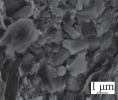 |
| 不规则状 | 形状不对称的形体 | 絮凝颗粒、黏土矿物、有机质-矿物颗粒结合体 |  | 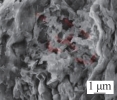 |
| 粒状体 | 具有相同等级量纲的不规则体 | 黄铁矿 |  | 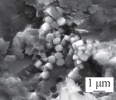 |
| 片状 | 板片形状 | 云母、蒙脱石、伊/蒙混层、绿/蒙混层等 |  | 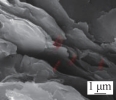 |
| 纤维状 | 规则或不规则的线状体 | 伊利石、云母等 |  | 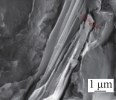 |
| 多孔状 | 表面或体内发育孔隙 | 生烃有机质、溶蚀的脆性矿物颗粒等 |  | 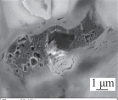 |
Table 2
Micromechanical parameters of mineral grains in the Chang 7 Member, Ordos Basin"
| 矿物颗粒 | 弹性模量分布区间/GPa | 弹性模量平均值/GPa | 硬度分布区间/GPa | 硬度平均值/GPa |
|---|---|---|---|---|
| 石英 | 22.84~125.43 | 69.62 | 3.10~38.80 | 12.10 |
| 长石 | 42.00~102.11 | 67.82 | 1.50~12.52 | 6.18 |
| 黏土矿物 | 7.30~99.34 | 50.38 | 1.37~11.17 | 4.85 |
| 方解石 | 11.17~113.70 | 55.73 | 1.44~7.09 | 4.03 |
| 白云石 | 25.13~77.57 | 49.76 | 0.82~12.93 | 4.32 |
| 黄铁矿 | 253.90~293.20 | 273.90 | 30.12~39.80 | 34.79 |
| 有机质 | 0.40~4.70 | 2.50 | 0.20~1.10 | 0.53 |
Table 3
Relationships between mineral grain types and mineral components in the Chang 7 Member, Ordos Basin"
| 矿物组分含量 | 相关系数R2 | |||||
|---|---|---|---|---|---|---|
| 类型一占比 | 类型二占比 | 类型三占比 | 类型四占比 | 类型五占比 | 类型六占比 | |
| 石英含量 | 0.214(+) | 0.554(-) | 0.526(-) | 0.269(+) | 0.871(+) | 0.009(+) |
| 长石含量 | 0.013(-) | 0.656(+) | 0.710(-) | 0.157(-) | 0.120(+) | 0.287(+) |
| 黄铁矿含量 | 0.342(+) | 0.467(-) | 0.243(-) | 0.659(+) | 0.230(-) | 0.260(-) |
| 黏土矿物含量 | 0.361(-) | 0.509(+) | 0.252(+) | 0.293(-) | 0.548(-) | 0.197(-) |
| TOC | 0.644(+) | 0.553(-) | 0.241(-) | 0.285(+) | 0.200(+) | 0.289(-) |
| 黏土矿物含量+TOC | 0.010(-) | 0.204(-) | 0.872(+) | 0.030(+) | 0.444(-) | 0.345(-) |
| 方解石+白云石+长石含量 | 0.070(-) | 0.285(+) | 0.730(-) | 0.207(-) | 0.100(+) | 0.453(+) |
| 1 | 姜在兴, 梁超, 吴靖, 等. 含油气细粒沉积岩研究的几个问题[J]. 石油学报, 2013, 34(6): 1031-1039. |
| JIANG Zaixing, LIANG Chao, WU Jing, et al. Several issues in sedimentological studies on hydrocarbon-bearing fine-grained sedimentary rocks[J]. Acta Petrolei Sinica, 2013, 34(6): 1031-1039. | |
| 2 | 张建国, 姜在兴, 刘鹏, 等. 陆相超细粒页岩油储层沉积机制与地质评价[J]. 石油学报, 2022, 43(2): 234-249. |
| ZHANG Jianguo, JIANG Zaixing, LIU Peng, et al. Deposition mechanism and geological assessment of continental ultrafine-grained shale oil reservoirs[J]. Acta Petrolei Sinica, 2022, 43(2): 234-249. | |
| 3 | 朱如凯, 李梦莹, 杨静儒, 等. 细粒沉积学研究进展与发展方向[J]. 石油与天然气地质, 2022, 43(2): 251-264. |
| ZHU Rukai, LI Mengying, YANG Jingru, et al. Advances and trends of fine-grained sedimentology[J]. Oil & Gas Geology, 2022, 43(2): 251-264. | |
| 4 | HILL R J, ZHANG Etuan, KATZ B J, et al. Modeling of gas generation from the Barnett Shale, Fort Worth Basin, Texas[J]. AAPG Bulletin, 2007, 91(4): 501-521. |
| 5 | JARVIE D M, HILL R J, RUBLE T E, et al. Unconventional shale-gas systems: The Mississippian Barnett Shale of north-central Texas as one model for thermogenic shale-gas assessment[J]. AAPG Bulletin, 2007, 91(4): 475-499. |
| 6 | 郭旭升, 马晓潇, 黎茂稳, 等. 陆相页岩油富集机理探讨[J]. 石油与天然气地质, 2023, 44(6): 1333-1349. |
| GUO Xusheng, MA Xiaoxiao, LI Maowen, et al. Mechanisms for lacustrine shale oil enrichment in Chinese sedimentary basins[J]. Oil & Gas Geology, 2023, 44(6): 1333-1349. | |
| 7 | 王红岩, 周尚文, 赵群, 等. 川南地区深层页岩气富集特征、勘探开发进展及展望[J]. 石油与天然气地质, 2023, 44(6): 1430-1441. |
| WANG Hongyan, ZHOU Shangwen, ZHAO Qun, et al. Enrichment characteristics, exploration and exploitation progress, and prospects of deep shale gas in the southern Sichuan Basin, China[J]. Oil & Gas Geology, 2023, 44(6): 1430-1441. | |
| 8 | 操应长, 梁超, 韩豫, 等. 基于物质来源及成因的细粒沉积岩分类方案探讨[J]. 古地理学报, 2023, 25(4): 729-741. |
| CAO Yingchang, LIANG Chao, HAN Yu, et al. Discussions on classification scheme for fine-grained sedimentary rocks based on sediments sources and genesis[J]. Journal of Palaeogeography(Chinese Edition), 2023, 25(4): 729-741. | |
| 9 | 何文军, 吴和源, 杨森, 等. 准噶尔盆地玛湖凹陷风城组页岩油储层岩相划分与类型评价[J]. 西北地质, 2023, 56(1): 217-231. |
| HE Wenjun, WU Heyuan, YANG Sen, et al. Lithofacies division and type evaluation of shale oil reservoir in Fengcheng Formation of Mahu Sag, Junggar Basin[J]. Northwestern Geology, 2023, 56(1): 217-231. | |
| 10 | 黄军平, 杨田, 张艳, 等. 湖相细粒沉积岩沉积动力学机制与沉积模式——以鄂尔多斯盆地铜川地区延长组长7油层组露头为例[J]. 沉积学报, 2023, 41(4): 1227-1239. |
| HUANG Junping, YANG Tian, ZHANG Yan, et al. Sedimentary dynamics and deposition model of lacustrine fine-grained sedimentary rocks: A case study of the Chang 7 oil member from the Yanchang Formation in the Ordos Basin, Tongchuan area[J]. Acta Sedimentologica Sinica, 2023, 41(4): 1227-1239. | |
| 11 | ARTHUR M A, SAGEMAN B B. Marine black shales: Depositional mechanisms and environments of ancient deposits[J]. Annual Review of Earth and Planetary Sciences, 1994, 22: 499-551. |
| 12 | 贾承造, 张永峰, 赵霞. 中国天然气工业发展前景与挑战[J]. 天然气工业, 2014, 34(2): 1-11. |
| JIA Chengzao, ZHANG Yongfeng, ZHAO Xia. Prospects of and challenges to natural gas industry development in China[J]. Natural Gas Industry, 2014, 34(2): 1-11. | |
| 13 | 柳波, 吕延防, 孟元林, 等. 湖相纹层状细粒岩特征、成因模式及其页岩油意义——以三塘湖盆地马朗凹陷二叠系芦草沟组为例[J]. 石油勘探与开发, 2015, 42(5): 598-607. |
| LIU Bo, Yanfang LYU, MENG Yuanlin, et al. Petrologic characteristics and genetic model of lacustrine lamellar fine-grained rock and its significance for shale oil exploration: A case study of Permian Lucaogou Formation in Malang Sag, Santanghu Basin, NW China[J]. Petroleum Exploration and Development, 2015, 42(5): 598-607. | |
| 14 | XIE Xinhui, DENG Hucheng, HU Lanxiao, et al. Assessing the effect of oriented structure characteristics of laminated shale on its mechanical behaviour with the aid of nano-indentation and FE-SEM techniques[J]. International Journal of Rock Mechanics and Mining Sciences, 2024, 173: 105625. |
| 15 | 解馨慧. 细粒沉积岩颗粒定向结构特征及形成机理研究[D]. 成都理工大学,2022. |
| XIE Xinhui. Research on Grain Orientation Structure Characteristics and Formation Mechanism of Fine-grained Sedimentary Rocks [D]. Chengdu University of Technology, 2022. | |
| 16 | 李天军, 黄志龙, 张亦婷, 等. 吐哈盆地胜北洼陷七克台组浅水湖相细粒沉积岩岩相特征、成因模式及页岩油意义[J]. 地质学报, 2021, 95(12): 3869-3884. |
| LI Tianjun, HUANG Zhilong, ZHANG Yiting, et al. Lithofacies characteristics and genetic model of shallow lacustrine fine-grained sediments and its geological significance for shale oil in the Qiketai Formation in the Shengbei subsag, Turpan-Hami Basin[J]. Acta Geologica Sinica, 2021, 95(12): 3869-3884. | |
| 17 | 熊亮, 邓虎成, 吴冬, 等. 四川盆地及其周缘下寒武统筇竹寺组细粒沉积特征与影响因素[J]. 石油实验地质, 2023, 45(5): 857-871. |
| XIONG Liang, DENG Hucheng, WU Dong, et al. Fine-grained sedimentary characteristics and influencing factors of the Lower Cambrian Qiongzhusi Formation in Sichuan Basin and on its periphery[J]. Petroleum Geology and Experiment, 2023, 45(5): 857-871. | |
| 18 | XIE Xinhui, DENG Hucheng, LI Yong, et al. Investigation of the oriented structure characteristics of shale using fractal and structural entropy theory[J]. Fractal and Fractional, 2022, 6(12): 734. |
| 19 | 孟颖, 王剑, 马万云, 等. 基于细粒岩石类型对玛湖凹陷下二叠统风城组烃源岩分类评价[J]. 吉林大学学报(地球科学版), 2022, 52(5): 1735-1746. |
| MENG Ying, WANG Jian, MA Wanyun, et al. Evaluation of hydrocarbon source rock characteristics of Lower Permian Fengcheng Formation in Mahu Sag based on fine grained sedimentary rock type[J]. Journal of Jilin University(Earth Science Edition), 2022, 52(5): 1735-1746. | |
| 20 | 周立宏, 蒲秀刚, 陈长伟, 等. 陆相湖盆细粒岩油气的概念、特征及勘探意义: 以渤海湾盆地沧东凹陷孔二段为例[J]. 地球科学, 2018, 43(10): 3625-3639. |
| ZHOU Lihong, PU Xiugang, CHEN Changwei, et al. Concept, characteristics and prospecting significance of fine-grained sedimentary oil gas in terrestrial lake basin: A case from the second member of Paleogene Kongdian Formation of Cangdong Sag, Bohai Bay Basin[J]. Earth Science, 2018, 43(10): 3625-3639. | |
| 21 | 朱毅秀, 金振奎, 金科, 等. 中国陆相湖盆细粒沉积岩岩石学特征及成岩演化表征——以四川盆地元坝地区下侏罗统大安寨段为例[J]. 石油与天然气地质, 2021, 42(2): 494-508. |
| ZHU Yixiu, JIN Zhenkui, JIN Ke, et al. Petrologic features and diagenetic evolution of fine-grained sedimentary rocks in continental lacustrine basins: A case study on the Lower Jurassic Da’anzhai Member of Yuanba area, Sichuan Basin[J]. Oil & Gas Geology, 2021, 42(2): 494-508. | |
| 22 | 宋世骏. 柴达木盆地新生代咸化湖盆细粒岩差异性发育机理及其地质意义[D]. 西安: 西北大学, 2022. |
| SONG Shijun. Different developing mechanism of fine-grained sediments in Cenozoic saline lakes in the Qaidam Basin and its geological implications[D]. Xi’an: Northwest University, 2022. | |
| 23 | 肖路安. 全球含油气细粒沉积岩研究进展[J]. 西部探矿工程, 2022, 34(3): 161-164. |
| XIAO Luan. Research progress on global oil and gas fine-grained sedimentary rocks[J]. West-China Exploration Engineering, 2022, 34(3): 161-164. | |
| 24 | 苏中堂, 陈洪德, 徐粉燕, 等. 鄂尔多斯盆地马家沟组白云岩地球化学特征及白云岩化机制分析[J]. 岩石学报, 2011, 27(8): 2230-2238. |
| SU Zhongtang, CHEN Hongde, XU Fenyan, et al. Geochemistry and dolomitization mechanism of Majiagou dolomites in Ordovician, Ordos, China[J]. Acta Petrologica Sinica, 2011, 27(8): 2230-2238. | |
| 25 | 宗廷博, 陈德照, 杨頔, 等. 鄂尔多斯盆地杭锦旗西部山西组致密砂岩储层特征及物性控制因素[J]. 天然气地球科学, 2024, 35(4): 608-622. |
| ZONG Tingbo, CHEN Dezhao, YANG Di, et al. Tight sandstone reservoir characteristics and physical property control factors of Shanxi Formation in western Hangjinqi, Ordos Basin[J]. Natural Gas Geoscience, 2024, 35(4): 608-622. | |
| 26 | 古娜, 万友利, 丁晓琪, 等. 鄂尔多斯盆地富县地区延长组成岩相特征及控制因素[J]. 新疆地质, 2012, 30(3): 335-340. |
| GU Na, WAN Youli, DING Xiaoqi, et al. The lithofacies characteristics and influencing factors of Yanchang Formation in Fuxian, Ordos Basin[J]. Xinjiang Geology, 2012, 30(3): 335-340. | |
| 27 | XIE Xinhui, DENG Hucheng, FU Meiyan, et al. Evaluation of pore structure characteristics of four types of continental shales with the aid of low-pressure nitrogen adsorption and an improved FE-SEM technique in Ordos Basin, China[J]. Journal of Petroleum Science and Engineering, 2021, 197: 108018. |
| 28 | 勇子树. 鄂尔多斯盆地延长组长9油层组沉积相研究[J]. 石化技术, 2018, 25(10): 334. |
| YONG Zishu. Sedimentary facies study of Chang 9 reservoir in Yanchang Formation of Ordos Basin[J]. Petrochemical Industry Technology, 2018, 25(10): 334. | |
| 29 | 刘翰林, 邹才能, 邱振, 等. 陆相黑色页岩沉积环境及有机质富集机制——以鄂尔多斯盆地长7段为例[J]. 沉积学报, 2023, 41(6): 1810-1829. |
| LIU Hanlin, ZOU Caineng, QIU Zhen, et al. Sedimentary depositional environment and organic matter enrichment mechanism of lacustrine black shales: A case study of the Chang 7 member in the Ordos Basin[J]. Acta Sedimentologica Sinica, 2023, 41(6): 1810-1829. | |
| 30 | 解馨慧. 细粒沉积岩颗粒定向结构特征及形成机理研究[D]. 成都理工大学,2022. |
| XIE Xinhui. Research on Grain Orientation Structure Characteristics and Formation Mechanism of Fine-grained Sedimentary Rocks [D]. Chengdu University of Technology, 2022. | |
| 31 | 刘池洋, 赵红格, 王锋, 等. 鄂尔多斯盆地西缘(部)中生代构造属性[J]. 地质学报, 2005, 79(6): 737-747. |
| LIU Chiyang, ZHAO Hongge, WANG Feng, et al. Attributes of the Mesozoic structure on the west margin of the Ordos Basin[J]. Acta Geologica Sinica, 2005, 79(6): 737-747. | |
| 32 | 付金华, 李士祥, 牛小兵, 等. 鄂尔多斯盆地三叠系长7段页岩油地质特征与勘探实践[J]. 石油勘探与开发, 2020, 47(5): 870-883. |
| FU Jinhua, LI Shixiang, NIU Xiaobing, et al. Geological characteristics and exploration of shale oil in Chang 7 Member of Triassic Yanchang Formation, Ordos Basin, NW China[J]. Petroleum Exploration and Development, 2020, 47(5): 870-883. | |
| 33 | DENG Hucheng, XIE Xinhui, CHEN Ke, et al. Mineralogical characteristics of continental shale: a case study in Yan-Chang Formation, Ordos Basin[J]. Australian Journal of Earth Sciences, 2018, 65(6): 851-862. |
| [1] | Guoyong LIU, Jianqin XUE, Songtao WU, Kunyu WU, Boce ZHANG, Haoting XING, Na ZHANG, Peng PANG, Chao ZHU. Petroleum geology and ring-shaped distribution of the Paleogene-Neogene hydrocarbon resources in western Qaidam Depression,Qaidam Basin [J]. Oil & Gas Geology, 2024, 45(4): 1007-1017. |
| [2] | Qin ZHANG, Donglian LU, Kai WANG, Chang LIU, Mingqiang GUO, Mengjie ZHANG, Chaojie GUO, Ying WANG, Wenzhong HU, Xiaomin ZHU. Lithofacies classification and microscopic pore characteristics of fine-grained sedimentary rocks in the Hetang Formation, Lower Yangtze region [J]. Oil & Gas Geology, 2024, 45(4): 1089-1105. |
| [3] | Qianwen LI. Wettability and its major determinants of shale reservoirs in the Shahejie Formation, Dongying Sag, Bohai Bay Basin [J]. Oil & Gas Geology, 2024, 45(4): 1142-1154. |
| [4] | Yibo LI, Yaowang CHEN, Jinzhou ZHAO, Zhiqiang WANG, Bing WEI, Kadet Valeriy. Interaction mechanism between supercritical carbon dioxide and shale [J]. Oil & Gas Geology, 2024, 45(4): 1180-1194. |
| [5] | Xiaomin ZHU, Xiaolin WANG, Meizhou ZHANG, Xingyue LIN, Qin ZHANG. Sedimentary environments and lithofacies characteristics of fine-grained sediments in typical continental basins in China [J]. Oil & Gas Geology, 2024, 45(4): 873-892. |
| [6] | Zongquan HU, Zhongbao LIU, Qianwen LI, Zhoufan WU. Exploring source rock-reservoir coupling mechanisms in lacustrine shales based on varying-scale lithofacies assemblages: A case study of the Jurassic shale intervals in the Sichuan Basin [J]. Oil & Gas Geology, 2024, 45(4): 893-909. |
| [7] | Yuehao YE, Wei CHEN, Hua WANG, Jinmin SONG, Ying MING, Xin DAI, Zhiwu LI, Haofei SUN, Xiaogang MA, Tingting LIU, Hui TANG, Shugen LIU. Characteristics and determinants of shale reservoirs in the Upper Permian Dalong Formation, Sichuan Basin [J]. Oil & Gas Geology, 2024, 45(4): 979-991. |
| [8] | Minghe ZHANG, Xiangfeng WEI, Bo GAO, Jia RONG, Zhujiang LIU, Jihong YAN, Qihang YANG, Jiale WANG, Huiping LIU, Lang YOU, Ziliang LIU. Developmental models of organic-rich shales in the Cambrian Qiongzhusi Formation in the piedmont zone of northern Sichuan Basin [J]. Oil & Gas Geology, 2024, 45(4): 992-1006. |
| [9] | Huimin LIU, Youshu BAO, Maowen LI, Zheng LI, Lianbo WU, Rifang ZHU, Dayang WANG, Xin WANG. Geochemical parameters for evaluating shale oil enrichment and mobility: A case study of shales in the Bakken Formation, Williston Basin and the Shahejie Formation, Jiyang Depression [J]. Oil & Gas Geology, 2024, 45(3): 622-636. |
| [10] | Xiugang PU, Jiangchang DONG, Gongquan CHAI, Shunyao SONG, Zhannan SHI, Wenzhong HAN, Wei ZHANG, Delu XIE. Enrichment model of high-abundance organic matter in shales in the 2nd member of the Paleogene Kongdian Formation, Cangdong Sag, Bohai Bay Basin [J]. Oil & Gas Geology, 2024, 45(3): 696-709. |
| [11] | Weitao WU, Yansong FENG, Shixiang FEI, Yifei WANG, Heyuan WU, Xudong YANG. Enrichment factors and play fairway mapping for tight gas in the 5th member of the Permian Shiqianfeng Formation, Shenmu gas field, Ordos Basin [J]. Oil & Gas Geology, 2024, 45(3): 739-751. |
| [12] | Rui FANG, Yuqiang JIANG, Changcheng YANG, Haibo DENG, Chan JIANG, Haitao HONG, Song TANG, Yifan GU, Xun ZHU, Shasha SUN, Guangyin CAI. Occurrence states and mobility of shale oil in different lithologic assemblages in the Jurassic Lianggaoshan Formation, Sichuan Basin [J]. Oil & Gas Geology, 2024, 45(3): 752-769. |
| [13] | Jun LI, Youlong ZOU, Jing LU. Well-log-based assessment of movable oil content in lacustrine shale oil reservoirs: A case study of the 2nd member of the Paleogene Funing Formation, Subei Basin [J]. Oil & Gas Geology, 2024, 45(3): 816-826. |
| [14] | Xiaoyu DU, Zhijun JIN, Lianbo ZENG, Guoping LIU, Sen YANG, Xinping LIANG, Guoqing LU. Evaluation of natural fracture effectiveness in deep lacustrine shale oil reservoirs based on formation microresistivity imaging logs [J]. Oil & Gas Geology, 2024, 45(3): 852-865. |
| [15] | Caineng ZOU, Dazhong DONG, Wei XIONG, Guoyou FU, Qun ZHAO, Wen LIU, Weiliang KONG, Qin ZHANG, Guangyin CAI, Yuman WANG, Feng LIANG, Hanlin LIU, Zhen QIU. Advances, challenges, and countermeasures in shale gas exploration of underexplored plays, sequences and new types in China [J]. Oil & Gas Geology, 2024, 45(2): 309-326. |
| Viewed | ||||||
|
Full text |
|
|||||
|
Abstract |
|
|||||